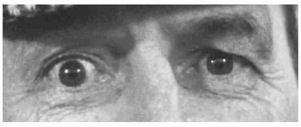
Empathy
Borderline “Empathy” Revisited
BPD and "mind in the eyes"
Posted July 29, 2009 Reviewed by Davia Sills
"The eyes of others our prisons; their thoughts our cages." —Virginia Woolf
Those intimately familiar with BPD have noted a paradox. On the one hand, people with BPD exhibit varying degrees of apparent distortion in the way they interpret the verbal and nonverbal communications of others. This often takes the form of ascribing hurtful intentions to others based on limited, selective, or ambiguous cues.
On the other hand, many have also observed an astute capacity in individuals with BPD to accurately read emotional expressions in others. People can be caught off guard if a person with BPD perceives their current emotional state, which they may not have been fully aware of themselves. Some BPD experts have labeled this acuity "borderline empathy."
Psychologist-Psychoanalyst Dr. Alan Krohn, in his classic 1974 paper, "Borderline ‘empathy' and differentiation of object representations: A contribution to the psychology of object relations," described this phenomenon in a young woman with BPD we will call Ms. L.
"[Ms. L] was hospitalized following periods of [disturbed] behavior at home, painting a neighbor's car, filling the refrigerator with cold cereal, indiscriminately using barbiturates, hallucinogens, and marijuana. She seemed unable to endure any separations from mother without intense anxiety or depression...
"Miss L. had a remarkable sensitivity to turmoil in other patients and staff [of the hospital]. [She] described strange ‘vibrations' from a staff member who, it later turned out, was in a great deal of turmoil over traumatic war experiences."
"She said of him, ‘There is something wrong with him; yesterday ... I looked at him, and he looked like he was seeing someone being killed.' It turned out that he was in fact preoccupied with thoughts of brutalities he witnessed in battle."
How do we study this paradoxical phenomenon scientifically, and might such research shed light on it?
My colleagues and I may have published one piece of the puzzle. We present findings in the journal Psychological Medicine, which suggest that individuals with BPD may have an enhancement in a particular form of emotion recognition called "mental state discrimination," when it is based on the eye region of the human face.
We compared individuals with BPD to individuals without any major forms of emotional disorder using a test called the "Reading the Mind in the Eyes Test."
The Mind in the Eye test assesses the capacity to discriminate the mental states of others using only stimuli from the eye region of the face by choosing the most accurate mental state from one of four mental state words. It is comprised of a total score and also scores for negative, positive, and neutral emotional expressions.
Here is an example of facial stimuli from the Reading the Mind in the Eyes Test.
What is this man feeling (correct answer at the end)?

1.Hateful
2. Jealous
3. Arrogant
4. Panicked
You can take this test yourself online at the following link.
When we compared individuals with BPD to healthy volunteers, we found something striking—the BPD group on average was more accurate than the healthy volunteers in discriminating the mental states.
The figure below indicates that individuals with BPD get more correct responses (indicated by percent correct on the vertical axis) than healthy volunteers on almost every scale of this test. The individuals with BPD do particularly well on neutral emotional expressions.
Interestingly, in contrast to BPD, Mind in the Eyes performance is impaired in other psychopathological conditions, such as schizophrenia and autistic disorders, suggesting differing underlying causes in these conditions compared to BPD.
This study suggests that, when not under elevated emotion stress, individuals with BPD have an enhanced ability to discriminate mental states based on only the eye region of the face, particularly for "neutral" states.
This experimental evidence is consistent with the "paradoxical" theory of the appraisal of social communication in BPD. That is, it seems that BPD is characterized by both unstable interpersonal relationships and enhanced sensitivity to the mental states of others.
For illustration, an individual with BPD may identify a subtle facial expression in the others indicating anger (e.g., furrowed brow in the eye region). The other person may indeed feel irritated, but not be fully focused or aware of this emotion in themselves at the time the emotion is noticed by the individual with BPD.
Interestingly, while frequently accurate in appraising the emotion, individuals with BPD often seem to "personalize" the emotions of others ("You must be angry with me"), even when there are other equally plausible explanations for the other's emotional state (e.g., the person just received troubling news from a friend).
Given the interpersonal and emotional sensitivity associated with BPD (such as concerns about abandonment, intense emotional reactions to rejection and abandonment cues), a hyper-attunement to subtle social cues may underlie aspects of BPD.
The emotional suffering underlying this attunement is alluded to by Virginia Woolf in the quote at the beginning of this post. This investigation and related research hold considerable promise in improving understanding of BPD.
Eventually, these findings will help in developing treatments that can be attuned to the unique way in which individuals with this disorder perceive people in their daily lives.
Correct answer to the question above: 4. "panicked"



